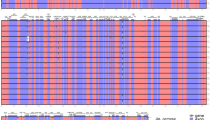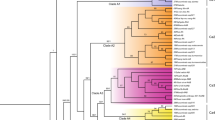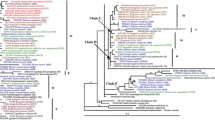Summary
The origin and evolution of a hybrid species complex in the genus Brassica (cabbage, turnip, mustard, rapeseed oil) has been explored through mutational analysis of the maternally inherited chloroplast genome. A detailed chloroplast DNA phylogeny enables identification of the maternal parent for most of the amphidiploids examined and permits quantitative resolution of the relative time of hybridization as well as the relative divergence of the diploid parents. Contradictory chloroplast and nuclear phylogenies obtained for two accessions of the amphidiploid B. napus (rapeseed oil) lead to the hypothesis that introgressive hybridization has also figured in their recent evolution.
Similar content being viewed by others
Abbreviations
- kb:
-
kilobase pairs
- bp:
-
base pairs
References
Anderson E (1953) Introgressive hybridization. Biol Rev 28:280–307
Avise JC, Giblin-Davidson C, Laerm J, Patton JC, Lansman RA (1979 a) Mitochondrial DNA clones and matriarchal phylogeny within and among geographic populations of the pocket gopher, Geomys pinetis. Proc Natl Acad Sci USA 76:6694–6698
Avise JC, Lansman RA, Shade RO (1979b) The use of restriction endonucleases to measure mitochondrial DNA sequence relatedness in natural populations. 1. Population structure and evolution in the genus Peromyscus. Genetics 92:279–295
Berggren G (1962) Reviews on the taxonomy of some species of the genus Brassica, based on their seeds. Sv Bot Tidskr 56:65–135
Bovenberg WA, Kool AJ, Nijkamp HJJ (1981) Isolation, characterization and restriction endonuclease mapping of the Petunia hybrida chloroplast DNA. Nucleic Acids Res 9:503–517
Brown GG, Simpson MV (1981) Intra- and interspecific variation of the mitochondrial genome in Rattus norvegicus and Rattus rattus: restriction enzyme analysis of variant mitochondrial DNA molecules and their evolutionary relationships. Genetics 97:125–143
Brown WM, George M Jr, Wilson AC (1979) Rapid evolution of animal mitochondrial DNA. Proc Natl Acad Sci USA 76:1967–1971
Brown WM, Prager EM, Wang A, Wilson AC (1982) Mitochondrial DNA sequences of primates: tempo and mode of evolution. J Mol Evol 18:225–239
Clausen J, Keck DD, Hiesey WM (1945) Plant evolution through amphiploidy and autoploidy with examples from the Madiinae. Carnegie Inst Washington Publ 564:1–174
Crawford DJ, Giannasi DE (1982) Plant chemosystematics. Bioscience 32:114–124
Dass H, Nybom H (1967) The relationships between Brassica nigra, B. campestris, B. oleracea, and their amphidiploid hybrids studied by means of numerical chemotaxonomy. Can J Genet Cytol 9:880–890
Dewet JMJ (1980) Origin of polyploids. In: Lewis WH (ed) Polyploids. Biological relevance. Plenum, New York, pp 3–15
Ferris SD, Wilson AC, Brown WM (1981) Evolutionary tree for apes and humans based on cleavage maps of mitochondrial DNA. Proc Natl Acad Sci USA 78:2432–2436
Fluhr R, Edelman M (1981) Conservation of sequence arrangement among higher plant chloroplast DNAs: molecular cross hybridization among the Solanaceae and between Nicotiana and Spinacia. Nucleic Acids Res 9:6841–6853
Gatenby AA, Cocking EC (1978) The evolution of fraction 1 protein and the distribution of the small subunit polypeptide coding sequences in the genus Brassica. Plant Sci Lett 12:299–303
Gordon KHJ, Crouse EJ, Bohnert HJ, Herrmann RG (1982) Physical mapping of differences in chloroplast DNA of the five wild-type plastomes in Oenothera subsection Euoenthera. Theor Appl Genet 61:373–384
Grant V (1981) Plant speciation. Columbia University, New York, pp 1–563
Gray JC (1980) Fraction 1 protein and plant phylogeny. In: Bisby FA, Vaughan JG, Wright CA (eds) Systematics association — special vol 16, Chemosystematics: principles and practice. Academic Press, London New York, pp 167–193
Karpechenko GD (1924) Hybrids of Raphanus sativus × Brassica oleracea L. J Genet 14:375–396
Kolodner R, Tewari KK (1975) The molecular size and conformation of the chloroplast DNA from higher plants. Biochim Biophys Acta 402:372–390
Kung SD, Zhu YS, Shen GF (1982) Nicotiana chloroplast genome. 3. Chloroplast DNA evolution. Theor Appl Genet 61:73–79
Lebacq P, Vedel F (1981) Sal I restriction enzyme analysis of chloroplast and mitochondrial DNAs in the genus Brassica. Plant Sci Lett 23:1–9
Link G (1981) Cloning and mapping of the chloroplast DNA sequence for two messenger RNAs from mustard (Sinapis alba L.). Nucleic Acids Res 9:3681–3694
Link G, Chambers WE, Thompson JA, Falk H (1981) Size and physical organization of chloroplast DNA from mustard (Sinapis alba L.) Mol Gen Genet 181:454–457
Maxam AM, Gilbert W (1980) Sequencing end-labeled DNA with base-specific chemical cleavages. In: Grossmann L, Moldave K (eds) Methods in enzymology, vol 65 I Academic Press, New York, pp 499–560
Olsson G (1960a) Species crosses within the genus Brassica. 1. Artificial Brassica juncea Coss. Hereditas 46:171–222
Olsson G (1960b) Species crosses within the genus Brassica. 2. Artificial Brassica napus L. Hereditas 46:351–396
Palmer JD (1982) Physical and gene mapping of chloroplast DNA from A triplex triangularis and Cucumis sativa. Nucleic Acids Res 10:1593–1605
Palmer JD (1983) Chloroplast DNA exists in two orientations. Nature 301:92–93
Palmer JD, Thompson WF (1981a) Clone banks of the mung bean, pea and spinach chloroplast genomes. Gene 15:21–26
Palmer JD, Thompson WF (1981b) Rearrangements in the chloroplast genomes of mung bean and pea. Proc Natl Acad Sci USA 78:5533–5537
Palmer JD, Thompson WF (1982) Chloroplast DNA rearrangements are more frequent when a large inverted repeated sequence is lost. Cell 29:537–550
Palmer JD, Zamir D (1982) Chloroplast DNA evolution and phylogenetic relationships in Lycopersicon. Proc Natl Acad Sci USA 79:5006–5010
Palmer JD, Edwards H, Jorgensen RA, Thompson WF (1982) Novel evolutionary variation in transcription and location of two chloroplast genes. Nucleic Acids Res 10:6819–6832
Palmer JD, Singh GP, Pillay DTN (1983a) Structure and sequence evolution of three legume chloroplast DNAs. Mol Gen Genet (in press)
Palmer JD, Shields CR, Cohen DB, Orton TJ (1983b) An unusual mitochondrial DNA plasmid in the genus Brassica. Nature 301:725–728
Prakash S, Hinata K (1980) Taxonomy, cytogenetics and origin of crop Brassica, a review. Opera Bot 55:1–57
Timothy DH, Levings CS III, Pring DR, Conde MF, Kermicle JL (1979) Organelle DNA variation and systematic relationships in the genus Zea: Teosinte. Proc Natl Acad Sci USA 76:4220–4224
Tohdoh N, Sugiura M (1982) The complete nucleotide sequence of a 16S ribosomal RNA gene from tobacco chloroplasts. Gene 17:213–218
UN (1935) Genomic analysis in Brassica with special reference to the experimental formation of B. napus and peculiar mode of fertilization. Jpn J Bot 7:389–452
Uchimiya H, Wildman SG (1978) Evolution of fraction 1 protein in relation to origin of amphidiploid Brassica species and other members of the Cruciferae. J Hered 69:299–303
Vaughan JG (1977) A multidisciplinary study of the taxonomy and origin of Brassica crops. Bioscience 27:35–40
Vedel F, Quetier F, Dosba F, Doussinault G (1978) Study of wheat phylogeny by EcoRI analysis of chloroplastic and mitochondrial DNAs. Plant Sci Lett 13:97–102
Vedel F, Quetier F, Cauderon Y, Dosba F, Doussinault G (1981) Studies on maternal inheritance in polyploid wheats with cytoplasmic DNAs as genetic markers. Theor Appl Genet 59:239–245
Verma SC, Rees H (1974) Nuclear DNA and the evolution of allotetraploid Brassica. Heredity 33:61–68
Wildman SG (1979) Aspects of Fraction 1 protein evolution. Arch Biochem Biophys 196:598–610
Wilson AC, Carlson SS, White TJ (1977) Biochemical evolution. Ann Rev Biochem 46:573–639
Zurawski G, Perrot B, Bottomley W, Whitfeld PR (1981) The structure of the gene for the large subunit of ribulose-1,5-bisphosphate carboxylase from spinach chloroplast DNA. Nucleic Acids Res 9:3251–3270
Author information
Authors and Affiliations
Additional information
Communicated by D. von Wettstein
Rights and permissions
About this article
Cite this article
Palmer, J.D., Shields, C.R., Cohen, D.B. et al. Chloroplast DNA evolution and the origin of amphidiploid Brassica species. Theoret. Appl. Genetics 65, 181–189 (1983). https://doi.org/10.1007/BF00308062
Received:
Accepted:
Issue Date:
DOI: https://doi.org/10.1007/BF00308062




